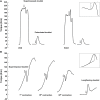Time-Course of Neuromuscular Changes during and after Maximal Eccentric Contractions
- PMID: 27148075
- PMCID: PMC4834740
- DOI: 10.3389/fphys.2016.00137
Time-Course of Neuromuscular Changes during and after Maximal Eccentric Contractions
Abstract
This study tested the relationship between the magnitude of muscle damage and both central and peripheral modulations during and after eccentric contractions of plantar flexors. Eleven participants performed 10 sets of 30 maximal eccentric contractions of the plantar flexors at 45°·s(-1). Maximal voluntary torque, evoked torque (peripheral component) and voluntary activation (central component) were assessed before, during, immediately after (POST) and 48 h after (48 h) the eccentric exercise. Voluntary eccentric torque progressively decreased (up to -36%) concomitantly to a significant alteration of evoked torque (up to -34%) and voluntary activation (up to -13%) during the exercise. Voluntary isometric torque (-48 ± 7%), evoked torque (-41 ± 14%) and voluntary activation (-13 ± 11%) decreased at POST, but only voluntary isometric torque (-19 ± 6%) and evoked torque (-10 ± 18%) remained depressed at 48 h. Neither changes in voluntary activation nor evoked torque during the exercise were related to the magnitude of muscle damage markers, but the evoked torque decrement at 48 h was significantly correlated with the changes in voluntary activation (r = -0.71) and evoked torque (r = 0.77) at POST. Our findings show that neuromuscular responses observed during eccentric contractions were not associated with muscle damage. Conversely, central and peripheral impairments observed immediately after the exercise reflect the long-lasting reduction in force-generating capacity.
Keywords: central activation ratio; evoked torque; muscle damage; plantar flexors; voluntary activation level.
Figures



Similar articles
-
Influence of fascicle strain and corticospinal excitability during eccentric contractions on force loss.Exp Physiol. 2019 Oct;104(10):1532-1543. doi: 10.1113/EP087664. Epub 2019 Aug 22. Exp Physiol. 2019. PMID: 31374136
-
Maximal force, voluntary activation and muscle soreness after eccentric damage to human elbow flexor muscles.J Physiol. 2005 Aug 15;567(Pt 1):337-48. doi: 10.1113/jphysiol.2005.087767. Epub 2005 Jun 9. J Physiol. 2005. PMID: 15946963 Free PMC article.
-
Neuromechanical properties of the triceps surae in young and older adults.Exp Gerontol. 2013 Nov;48(11):1147-55. doi: 10.1016/j.exger.2013.07.007. Epub 2013 Jul 22. Exp Gerontol. 2013. PMID: 23886750
-
Changes in central and peripheral neuromuscular fatigue indices after concentric versus eccentric contractions of the knee extensors.Eur J Appl Physiol. 2018 Apr;118(4):805-816. doi: 10.1007/s00421-018-3816-0. Epub 2018 Feb 6. Eur J Appl Physiol. 2018. PMID: 29411127
-
Larger strength losses and muscle activation deficits in plantar flexors induced by backward downhill in reference to distance-matched forward uphill treadmill walk.Eur J Sport Sci. 2018 Nov;18(10):1346-1356. doi: 10.1080/17461391.2018.1497091. Epub 2018 Jul 17. Eur J Sport Sci. 2018. PMID: 30016189
Cited by
-
Sex differences in neuromuscular function after repeated eccentric contractions of the knee extensor muscles.Eur J Appl Physiol. 2017 Jun;117(6):1119-1130. doi: 10.1007/s00421-017-3599-8. Epub 2017 Apr 21. Eur J Appl Physiol. 2017. PMID: 28432420
-
Internal Loads, but Not External Loads and Fatigue, Are Similar in Young and Middle-Aged Resistance-Trained Males during High Volume Squatting Exercise †.J Funct Morphol Kinesiol. 2018 Aug 22;3(3):45. doi: 10.3390/jfmk3030045. J Funct Morphol Kinesiol. 2018. PMID: 33466974 Free PMC article.
References
-
- Babault N., Pousson M., Ballay Y., Van Hoecke J. (2001). Activation of human quadriceps femoris during isometric, concentric, and eccentric contractions. J. Appl. Physiol. (1985) 91, 2628–2634. - PubMed
-
- Cohen J. (1988). Statistical Power Analysis for the Behavioral Sciences. Hillsdale, NJ: L. Erlbaum Associates.
LinkOut - more resources
Full Text Sources
Other Literature Sources
Medical

